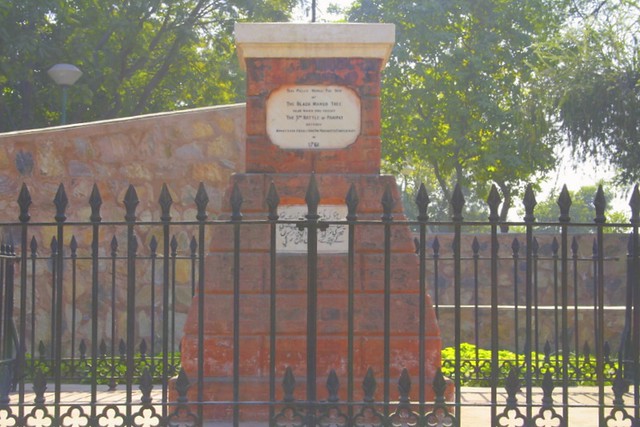
This work is licensed under a
Creative Commons Attribution-Noncommercial-No Derivative Works 2.5 India License.
The list of players playing the game for wresting control over North India from 1730s to 1800s.
1. Mughal: Spent force, allies of victor, whoever it may be. Titular head of India.
2. Najib: Pathan, Sunni, enemy of Mughals. I have discussed animosity of Pathan-Mughal in detail in this article. Najib was open aspirant of delhi throne (which was taken away from Pathans by Mughals under Babar) and hence a persona non grata.
3. Shuja: enemy of Najib and suspicious about alivardi khan. Shia-Muslim from Lucknow, hence in good terms with Marathas.
4. Abdali: General of Nadirshah, later king of Afghanistan. interested only in Punjab (region to west of Sutlaj). crossed sutlaj repeatedly only for looting.
5. Mullah class: Greatly pampered under Aurangzeb. Sirhindi stalled the integration process initiated by Dara Shikoh. Later Shah wali sensed loss of power to Hindu kings and raised the bogey of "Islam in danger". This bogeyman was craftily used by Najib to lure Abdali and Shuja.
6. Jat: interested in Delhi. staunchly anti muslims.
7. Rajputs: deracinated and uprooted force with no preferences. friend of whosoever controls delhi.
8. Sikhs: Ideologically motivated but not in position to raise huge army and supply columns.
9. Holkar: grand old man of Maratha faction. Suspicious about intentions of Shinde and Peshwa, hence friends with Najib. Probably he understood the power of Gardi's artillery and hence opposed it because he knew what would happen if this mode of warfare stuck in India.
10. Shinde: Great personal animosity with Najib. Amicable in action and spirit with Peshwa. Advocates of cavalry mode of warfare.
11. Peshwa: Perhaps the only faction with ambition to establish pan-subcontinental empire. However, subservient to emperor of Satara and bound by Shahu's promise to Aurangzeb regarding protection of Delhi.. Family history of Tuberculosis and loss of all capable men at very young age.
One of the most common "reason" which is cited as the main reason for Maratha defeat on Panipat is poor diplomacy by Marathas which left them friend-less in alien territory. While this is true, I feel this is the opinion formed owing to our luxury of hindsight.
Why was it that Marathas chose to hurt Surajmal Jat, yet count on Shuja of Lucknow to either help them against Abdali OR stay neutral at the least? Why did they give higher preference to Shia Muslim Shuja and not Hindu Jat? I will deal with Sikh, Jat, Rajput and Shuja faction. In this article, I will discuss the Sikh angle in Mughal-Maratha relations during Panipat Campaign.
Following is the analysis for non-alignment of Sikhs for the Maratha-cause..
Sikhs were not organised by 1750. It was after 1762 that Sikhs started becoming a force to reckon with. Even if there were a support base for, Marathas in punjab, there are many operational problems..
Village is fundamental structural and functional unit of India. On an average every village had 200 households (my estimate). Villagers leave their homes and either take refuge of forests OR fortified cities when Pathans cross Sindhu and descend on plains of Punjab . If they go to fortified cities, they fight for its defence and live if city prevails and die if city falls. If they go to forests, they live if they have enough rations, OR die of hunger, animals, enemy OR nature. Given the sparse nature of towns and cities in medieval times, most of the people took refuge of forests, abandoning the land.
Ruler needs encourage people to return to their lands and till it. Even if Punjab was taken by Marathas for purpose of tax (Punjab has and had very high tax potential similar to bengal), it would have taken at least 4-5 years of stable occupation for people to start paying chauth. The net income of Marathas in Punjab campaign (in spite of the loot) was negative because there was nothing left to loot.
Furthermore, while Sikhs were harrassing Abdali using guerilla warfare tactics, it is easy for Sikhs than Marathas, to do so for two reasons.
A. It was their home-base.
B. Their armies were not so huge and sophisticated, hence the supplies were very simple ones. Not many horses, cheap weapons, no elephants, no artillery (and associated maintenance crew for all units), no royal women with all their luxuries (relatively). For such an army, the list of items to be supplied is really long.
Punjab and Sikhs (even if they were friends of Marathas) were not in position to fulfill this demand of such a huge army. It is easy to feed a fighting band of 200-300 men. It is takes huge toll to feed a gathering of 400,000 men and about million animals. No village, town, citadel or power centre of sikhs were in position to make the supplies.
To be continued...

.JPG)

